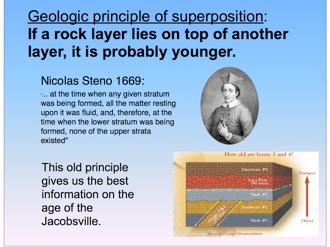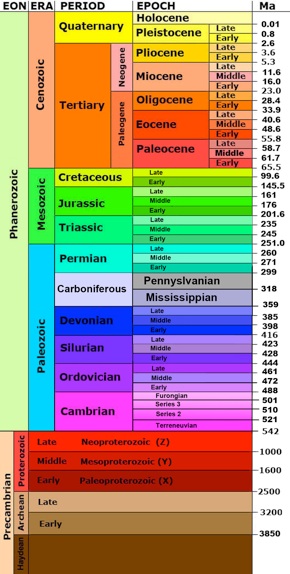Age of Jacobsville SS

Age of rocks?--when was the sandstone laid down in layers?

Dating rocks requires either high temperature conditions that set radioactive clocks which can be read in the laboratory, or fossils which are known to represent particular ages. The Jacobsville has no high T rocks (lavas, granites) formed within it and has no fossils that have age information. We can only look at the younger rocks above it and the lower rocks below to get its age.

First, let’s look at the rocks above the Jacobsville, exposed at Pictured Rocks, just above the waterline in the photo below.
The contact between formations always attracts the attention of geologists. We now agree that the contact along that yellow line is an unconformity which probably means that 400 million years of rock record are missing here!


So, what is underneath the Jacobsville? We had to wait for wildcat drillholes to find out.

Two very significant wildcats were completed in the midwestern section of the U.S. between October 1987 and April 1992. At the time information regarding these ventures was sought by a wide circle of observers ranging from corporate scouts to geologists. Because of the secrecy surrounding both boreholes, little to no information was available until very recently.
These wildcats, both near Munising, drilled all the way through the Jacobsville and into the Freda Sandstone--another redbed formation found along the north shore of the Keweenaw, that lies directly and conformably on the very well dated Keweenaw Rift Lavas.

Our best estimate of the age of the Jacobsville Sandstone is younger than 960 ma, likely corresponding to Neoproterozoic. This is a critical time in Earth’s history, when supercontinents dominated, when oxygen was building in Earth’s ocean and atmosphere, and during the Snowball Earth.

Earth’s age is about 4.5 by, while written history is only thousands of years long, human history millions of years and complex living organisms hundreds of millions of years. Knowing Earth’s age adds vital understanding to earth and its processes.
A View from the Back of the Envelope
Geological Time Analogy from Wales
Geologic Time: The Story of a Changing Earth
Geological Time & Paleobiology
Geological Time--Virtual Fossil Museum
Geologic Time--Windows to Universe
Geologic Time --Carleton
Scotese Data
Paleo-maps (650 Ma to +250 Ma)
Animations of the ancient globe
Paleo-maps (600 Ma to Present)
Excel Files
Power Point files

The most important age constraint for the Jacobsville comes from study of its zircons, work that has been led by David Malone. This recent work has dated hundreds of grains in the formation with several age clusters, and a youngest age of 960 ma.

Schematic diagram of Pictured Rocks Cliffs, naming the formations.
Mosquito Beach
Pictured Rocks



